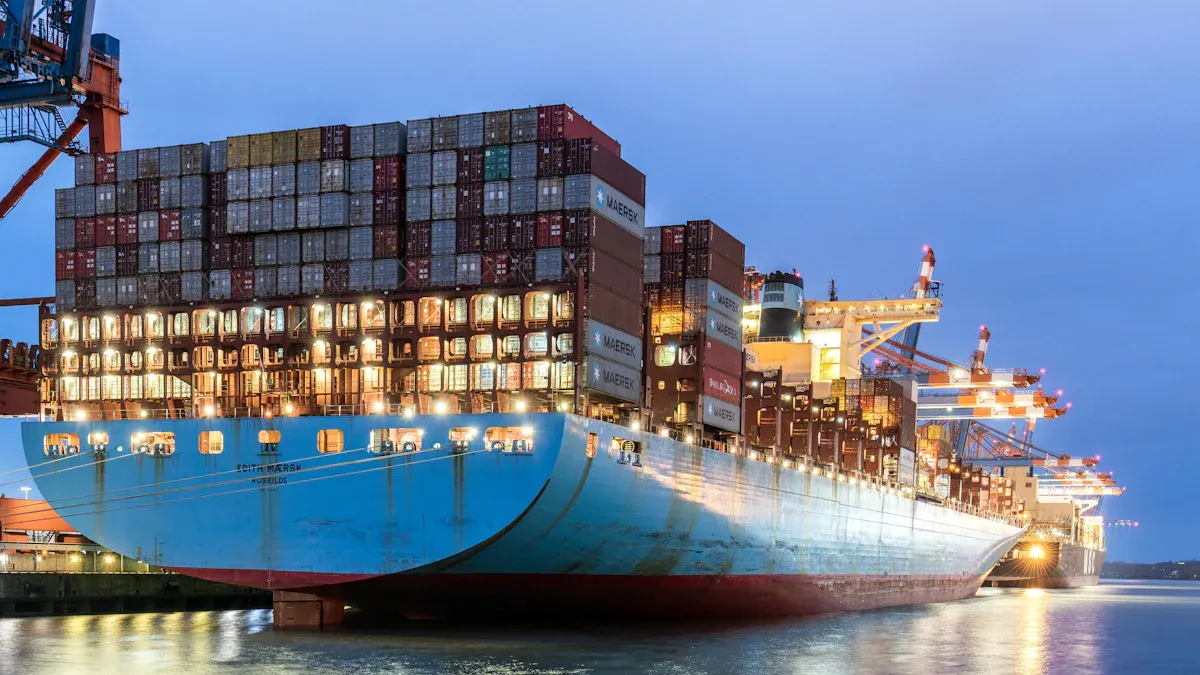What is International Warehousing and Why It Matters in 2025

International warehousing, including overseas logistics warehousing, involves storing goods in various countries, which enhances the efficiency of the global supply chain. As the world becomes increasingly interconnected, supply chains are becoming more complex. By 2025, the global warehousing market is projected to reach a value of $1.5 trillion, growing at an annual rate of 7%. Effective warehousing can reduce delivery times by half and decrease shipping costs by 25%. This ultimately enables businesses to serve customers more quickly and save money.
Key Takeaways
Warehouses in other countries help supply chains by keeping goods near customers. This makes deliveries faster and lowers shipping costs.
Using smart tools like AI and IoT in warehouses helps track items better, avoids mistakes, and makes work smoother.
Spending money on global warehouses helps businesses handle changes, keeps customers happy, and grows the business without spending too much.
Understanding International Warehousing in Global Supply Chains

Definition and Key Characteristics
International warehousing means placing storage buildings in different countries. This helps businesses with global trade and moving goods. These warehouses are important for storing, organizing, and delivering products quickly. By 2025, the warehousing market will grow a lot because of more retail stores and higher demand for storage in places like North America.
Main features of international warehousing include:
Global Reach: Warehouses are near big markets and transport centers.
Advanced Technology: They use tools like IoT, AI, and robots to work better.
Scalability: Warehouses can handle changing inventory sizes and seasonal needs.
Regulatory Compliance: They follow local trade and customs rules carefully.
Studies show this industry is growing fast. From 2025 to 2034, the market will grow by 11.68% each year. By 2034, it will reach $5,077.15 billion, up from $1,682.11 billion in 2025. This shows how important international warehousing is for global trade.
Role of Overseas Logistics Warehousing in Global Trade
Overseas logistics warehousing helps with cross-border trade and makes supply chains faster. By keeping goods closer to customers, companies can ship faster and meet delivery expectations. These warehouses also make customs easier, following local rules and avoiding delays.
Benefits of overseas logistics warehousing include:
Benefit | Explanation |
|---|---|
Faster delivery times | Goods are stored near customers, cutting shipping time. |
Cost savings | Combining shipments lowers transport costs and saves money. |
Better customer satisfaction | Quick delivery and available products make customers happy. |
Easier customs processes | Warehouses follow rules, avoiding delays in shipping. |
Market growth opportunities | Helps businesses enter new areas and connect with more customers. |
Using overseas logistics warehousing saves money, improves operations, and helps businesses grow. This is especially useful for e-commerce, where speed and reliability matter most.
How JUSDA’s Warehouse Solutions Support International Warehousing
JUSDA’s warehouse solutions show how smart planning and technology improve international warehousing. With over 2.5 million square meters of space worldwide, JUSDA offers custom solutions for industries like electronics, cars, and FMCG.
JUSDA uses advanced tools like IoT and AI to manage inventory better. Its JusLink platform tracks goods in real-time and keeps inventory accurate. This system also helps suppliers and buyers work together, reducing risks and improving decisions.
Examples show how JUSDA’s solutions work:
Company | Technology Used | Outcome |
|---|---|---|
FedEx | IoT sensors and AI analytics | Better tracking and delivery routes, saving money and pleasing customers. |
DHL | AR technology | Boosted productivity by 25%, showing how smart tools help operations. |
JUSDA’s global warehouse network and smart technology help businesses handle cross-border challenges. Whether you need special warehouses or delivery centers, JUSDA keeps your supply chain strong and competitive.
Strategic Importance of International Warehousing
Enhancing Global Supply Chain Efficiency
International warehousing helps make global supply chains work better. By placing warehouses near customers, delivery becomes faster and smoother. This setup avoids delays and meets customer needs quickly, especially in e-commerce and FMCG industries.
Benefits of international warehousing include:
Quick Fulfillment: Nearby warehouses speed up delivery times.
Lower Shipping Costs: Shipping in bulk saves money on transport.
Better Return Services: Easier returns make customers happier.
Minimized Supply Chain Risks: Spread-out warehouses reduce risks from disasters or conflicts.
JUSDA uses smart tools like IoT and AI to manage inventory better. These tools show stock levels in real-time, helping avoid delays and make smarter choices. With these strategies, businesses can build strong and flexible systems for cross-border operations.
Tip: Investing in international warehousing helps your business stay ready for market changes while improving supply chain efficiency.
Reducing Costs with Strategic Warehouse Management
Good warehouse management lowers costs in global logistics. Smart systems, like JUSDA’s, use IoT and automation to save energy and resources. These tools cut down on mistakes, reduce labor needs, and improve operations, saving money.
Reports show that advanced systems help businesses work better. Automation and tracking lower transport costs and use storage space wisely. For example, JUSDA’s JusLink platform matches inventory to demand, avoiding extra stock and cutting costs. This frees up money for other business needs.
Smart warehouse management also combines shipments, reducing trips and transport expenses. This saves money and helps the environment by lowering emissions.
Note: Using smart warehouse practices supports cost-effective growth and keeps operations running smoothly.

JUSDA Solutions
To provide you with professional solutions and quotations.
Improving Customer Satisfaction Through Global Warehousing
Global warehouses improve customer satisfaction by delivering products on time. When warehouses are near key markets, orders arrive faster, boosting trust and loyalty. Happy customers are more likely to buy again.
Important metrics for global warehousing include:
Order Lead Time: Faster deliveries make customers happier.
On-Time Shipment Rate: Reliable deliveries build trust.
Net Promoter Score (NPS): High NPS means customers recommend your business.
Customer Feedback Forms: Feedback helps improve your services.
JUSDA’s warehouses store and ship products efficiently to meet customer needs worldwide. Tools like JusLink track shipments in real-time, solving problems quickly. These solutions create a smooth experience that helps businesses stand out.
Tip: Use metrics like NPS and lead times to check how well your global warehousing works and find ways to improve.
Benefits and Challenges of International Warehousing
Benefits: Faster Delivery, Cost Savings, and Risk Mitigation
International warehousing has many benefits for supply chains. Faster delivery helps businesses fulfill orders quickly, especially in e-commerce and FMCG. Storing goods closer to customers lowers shipping costs and meets delivery needs.
Key performance indicators show these advantages:
Lead Time (Order Cycle Time): Shorter times make customers happier.
Delivery Time: On-time deliveries build trust and loyalty.
Order Accuracy Rate: Correct orders reduce returns and save money.
Performance Indicator | Benefit Supported |
|---|---|
Inventory Accuracy | Saves money and reduces risks |
Order Picking Accuracy | Speeds up delivery and pleases customers |
Perfect Order Rate | Cuts costs and improves satisfaction |
Order Cycle Time | Speeds delivery and boosts efficiency |
Inbound Throughput | Saves money and lowers risks |
Smart systems like JUSDA’s JusLink platform help manage inventory better. They cut mistakes and show stock levels in real-time. This ensures smooth order delivery across borders.
Note: Automation saves money and improves efficiency but needs big investments. It may also be less flexible during busy times.
Challenges: Logistical Complexities and Regulatory Compliance
Global warehousing has its challenges. Managing shipments across borders can be tricky. Different transport costs and risks make it harder. Following rules in each country adds more difficulty.
You need to handle changing customs rules, trade laws, and agreements. Staying updated is key to avoiding fines, delays, or losing goods.
Common issues in global warehousing include:
Different customs rules in each country.
Tariffs and trade limits that slow operations.
Legal risks from not following local laws.
Tip: Work with experts like JUSDA to solve these problems. They offer custom solutions and expert advice.
JUSDA’s Approach to Overcoming Challenges in Warehouse Management
JUSDA solves warehousing problems with smart tools. Their systems use advanced tech to make work easier and faster.
Challenge | Solution |
|---|---|
Use just-in-time systems to need less storage space. | |
Labor Costs | Add automation like conveyor belts to lower labor costs. |
Supply Chain Disruptions | Plan backups with extra suppliers and shipping routes. |
Inventory Management | Use tracking systems to manage stock and avoid mistakes. |
JUSDA’s JusLink platform uses IoT and AI to track inventory live. These tools keep operations smooth, even during problems. By mixing automation with planning, JUSDA helps cut shipping costs and solve warehouse challenges.
Callout: JUSDA’s tools help businesses handle global warehousing while staying efficient and following rules.
Trends and Technologies Shaping International Warehousing in 2025
Automation and Robotics in Global Warehousing
Automation and robotics are changing how warehouses work. Machines like conveyor belts and robotic arms help with packing and sorting. This makes tasks faster and reduces mistakes. Automated Guided Carts (AGC) move items around, keeping inventory correct and cutting transport costs.
Robots also make workplaces safer. They lift heavy items, so workers avoid injuries. Companies like PUMA use AutoStore systems to create cleaner and better workspaces. Workers feel happier and safer with these changes. Automation also creates new jobs, like managing robots, which are easier on the body.
Tip: Using automation improves speed and safety while helping workers stay healthy.
AI and IoT for Optimized Warehouse Management
AI and IoT are making warehouse management smarter. AI tracks inventory and predicts what is needed, avoiding too much or too little stock. This saves money and ensures orders are ready on time. IoT devices share data instantly, so warehouses know their stock levels quickly.
These tools are important for handling global warehouses. IoT sensors check storage conditions to keep products safe. AI finds equipment problems early, stopping delays. Together, they make warehouses more efficient and help managers make better choices.
Callout: AI and IoT are key to running smooth international warehouses, especially when expanding globally.
JUSDA’s JusLink Platform and Its Role in Future Warehousing
JUSDA’s JusLink platform shows how technology improves warehouses. It uses IoT and AI to track inventory live and predict future needs. This system lowers transport costs by combining shipments and finding better routes.
JusLink also helps suppliers and buyers work together. It predicts demand accurately, avoiding extra stock and saving resources. With JusLink, businesses can solve supply chain problems and prepare for global growth.
Note: JUSDA’s JusLink platform helps businesses stay strong in the changing world of global warehousing.
International warehousing is crucial for global trade. It helps supply chains work better, lowers shipping costs, and keeps customers happy. New tools like AI and IoT are changing warehouses, making them faster and smarter. Using smart warehousing methods can help you succeed in 2025's tough global market.
The global warehousing market may grow to $634 billion by 2028.
Warehousing solutions speed up shipping and help businesses reach global customers.
Tip: Use advanced tools to stay ahead in the changing world of global warehousing.
See Also
Exploring Advantages of Automation in Modern Manufacturing Warehouses
The Importance of Automation in Today's Warehouse Operations
Transforming Logistics with AI: The Future of Supply Chains
Five Key Trends Shaping Future Supply Chain Efficiency
Understanding Robotic Automation: Enhancing Efficiency in Warehousing
